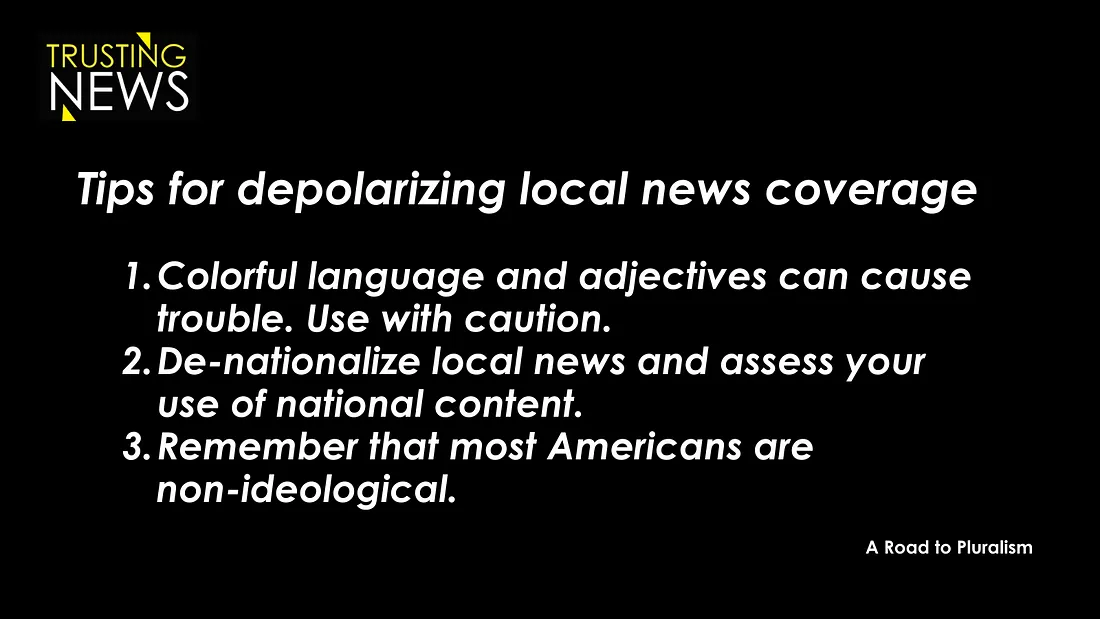
If newsrooms can avoid polarizing writing and editing choices, they may be able to retain and attract more readers from the full political spectrum. That’s the thinking behind a resource Trusting News has been testing and refining.
Research insights: What we learned testing an anti-polarization checklist with news consumers
This post was written by Trusting News research partners Joshua Darr and Patrick Johnson.
In a polarized political world, it’s not easy for the news to reflect something closer to the middle. Polarizing, in its simplest form, means two points are far from each other — think the North and South Poles. In politics, polarization can mean many things but often comes back to that same concept: distance.
Sometimes that means ideological distance about policies, but mostly it means partisan polarization: some Democrats and Republicans being far apart on the pressing problems of the day, the solutions to those problems, and whether they find the other side likable. Particularly in national politics, this dynamic defines partisan interactions: Democrats and Republicans can’t agree, and lob insults and criticisms back and forth over a widening valley.
Local politics isn’t necessarily any less contentious. There are partisan disputes in state houses and city council chambers, but many local concerns cut across partisan categories, and many local offices are officially (if not perfectly) non-partisan. The tips we’re sharing here are meant to be used for both national and local stories — and perhaps most of all in local stories with a national politics angle.
Readers want local news to be local: Many are turning to local news to avoid the national political debates of the day. In cases where journalists see a connection to national politics, however, it can be difficult to leave the dots unconnected. But bringing national frames into local stories might alienate readers and drive them further apart.
If newsrooms can avoid polarizing writing and editing choices, they may be able to retain and attract more readers from the full political spectrum. That’s the thinking behind a resource Trusting News has been testing and refining.
We’ve created an anti-polarization checklist to be used by newsrooms.
Here’s what we’ve learned
- Bold! Flashy! Snarky! Colorful language and adjectives are trouble. This is especially true with political coverage, stories mentioning race and stories where you add labels to people or their beliefs.
- De-nationalize local news. Assess when wire stories and op-eds about strictly national and non-local topics actually belong on your website; readers get confused and feel alienated.
- Most Americans are non-ideological: neither liberal nor conservative. Choose words and sources accordingly. There is a fundamental disconnect between people who know a lot about politics and are active participants in it, or “political elites,” and the general public. Source from the middle, not just the extremes.
About our project
As part of our Road to Pluralism initiative, we’ve worked with the following five newsrooms over two months:
- Albany Times Union (Tena Tyler and Brendan Lyons)
- Chattanooga Times Free Press (Alison Gerber, Ricky Young, Colin Stewart and Lew Gilliland)
- Iowa Falls Times Citizen (Sara Konrad Baranowski, Justin Ites and Matthew Rezab)
- Sacramento Bee (Bill Turque and Emilie Stigliani)
- Shasta Scout (Annelise Pierce and Marc Dadigan)
Here’s how it worked:
- The newsrooms agreed to use the anti-polarization checklist for their stories to cut down on polarizing language and topics, editing and reporting their stories according to the questions and tips listed there.
- We had conversations with staffers throughout the project, talking about what worked and what didn’t and getting their insights on reader reactions.
- Participating newsrooms also kept a log of how they changed or thought differently about their stories as a result of the checklist (although many stories were influenced by the checklist from the outset).
- Newsrooms received a $2,000 stipend at the conclusion of the project, thanks to funding from the Mercatus Center.
What follows are some simple steps editors and writers in local newsrooms can take to avoid increasing the distance between readers of different political leanings — and between themselves and their audiences.
Note: To honor the agreement the researchers for this project had with all journalists and community members involved in the work, we are not using names in the quotes included below.
Bold! Flashy! Snarky! Colorful language and adjectives are trouble
For some, this may be difficult to hear but many reader complaints are about the use of definitive language or illustrative descriptors.
We understand using less definitive and meaningful language is not as engaging to writers. If someone does not win an election, are they the “loser” or did they have an “unsuccessful run”? Did they “fail to win”? Connecting January 6 to past tragedies in American history, such as the attack on Pearl Harbor by using the word “infamy,” may seem innocuous, but readers took notice.
One editor was aggressive about this, instructing reporters to only ever use the word “said” when introducing a quote — no “exclaimed,” “shouted,” “mused,” or “whispered” allowed. (That sound you hear is reporters yawning.) Anything other than “said” implies an interpretation that immediately raises the suspicions of distrustful readers.
The words you choose can imply perspective or judgment in unforeseen ways. For example, words like “even,” “only,” and “just” modify what comes next by making it seem like there is a correct quantity of whatever it is — and that you stand on one side of it. Over and over, conservative readers were turned off by any language that was not “sanitized” or “clinical.” They feel adjectives are used against them. One editor said:
“The reporter used the word ‘flashy’ to describe a Republican candidate when they did not use adjectives to describe the Democratic candidates discussed in the story. In my editing note to the reporter I asked why they used that adjective and if it was necessary … This felt unnecessary and possibly polarizing.”
Conservative readers seem particularly aware of the use of adjectives, to the point where each adjective should be scrutinized rather than applied equally to both parties. If modifiers are not necessary, it might make sense to remove them.
In general, language that is inclusive of one group implies a perspective to many readers. How journalists refer to groups and identities should be double-checked if depolarization is the goal, particularly if descriptors are not relevant to a story.
For example, with regard to abortion rights: one story described the opposing groups as “pro-choice and “anti-abortion,” which was seen as less fair and consistent than “pro-choice” and “pro-life.” At the same time, editors may recommend against referring to LGBT people as “queers” because that feels like it’s writing from inside the LGBT community, not using a neutral journalistic voice.
Race was a particularly touchy label to apply in stories: Some may believe it is relevant across many contexts, while other readers resent the implication that it is. One reader commented:
“The [newspaper] as with their masters at AP, WaPo and NYTimes always stress race when it promotes their stereotype that all whites are irredeemable and the cause of all problems.”
Critical readers alleged the race of the perpetrator was not mentioned when the accused is Black and the victim is white. In other stories, editors noticed the inclusion of race in issues where there was not necessarily a racial dividing line. A meeting of students about gun violence, for example, originally contained racial descriptors, but these were removed. However, if someone was beaten by police for jaywalking, the editors agreed it matters if that person was Black and in a white neighborhood.
The question for journalists, of course, lies at the heart of the problem of polarization: by taking a stance on either side, journalists risk alienating the other (and a large segment of their consumer base). But by staying sanitized and clinical, journalists may be depriving other readers of the context they want.
It is important to recognize there is a balance here: when context or descriptors may drive some readers away, but leaving them out feels incomplete given broader national conversations. Every situation will be different, but we hope the checklist at least encourages you to pause and consider the tradeoffs before linking local stories to broader contexts.
De-nationalize local news
Tamping down polarization means focusing on less political conflict, and there is a clear way to do that. We suggest including stories about national politics sparingly, if at all. It’s time to question whether wire stories and op-eds about strictly national and non-local topics belong on your website; readers get confused and feel alienated.
We found in our prior project on polarizing wire content that readers were holding newsrooms accountable for perceived bias and polarizing content in wire stories from national sources like the Associated Press and Washington Post. It didn’t matter if the news source wrote the story — if it appeared there, it was harmful to their reputation.
In many cases, it is difficult to turn down the easy-to-publish option of a wire story that politically involved customers will likely engage with. But we found that consumers are not thrilled when their local newspaper gives them a wire story. Conservative readers adopted a “there they go again” attitude towards perceived liberal coverage from national wire sources. One commented:
“One has to take these AP articles with a grain of salt, and a huge shot of Casa Amigos. AP are mostly political activists as opposed to journalists.”
Regardless of whether you agree, it’s troubling a newsroom is getting punished for content it did not write. The national/local divide is too much to overcome, and readers get stuck on the non-local focus. One commented:
“WAPO is at it again. Jan. 6 is, was and should be condemned by all, regardless of party affiliation … but where are the heartbreaking stories of the many small business owners, many of whom are people of color, whose lives were destroyed by out of control BLM and Antifa rioters all over the country? … Is it because one atrocity affected the elitist political society in DC and the other affected common people in local communities?”
Keeping the focus local can make it more difficult for readers to connect what they see in a local news source to the arguments and stories they are absorbing through their national news consumption, through other websites or cable television. In other words, it’s not all national politics: Think about what “less polarized” means in the context of your community. One size will not fit all.
For the purposes of this checklist, ask yourself: Does this story need to connect to national themes? Does my community’s news require a comparison to similar stories from around the country? Our participating newsroom, the Chattanooga Times Free Press, confronted this directly in the aftermath of a local mass shooting. An editor told us:
“I cut short some of the descriptions of other recent shootings across the country. I felt like it was drawing the reader to compare Chattanooga’s shooting with other shootings. I felt like they were very different scenarios and we could be accused of trying to make some kind of political statement by some readers by drawing too close a comparison with other shootings.”
Broader significance and relevance to national trends are important factors for a story. But lumping local events in with national stories, much like including national stories in a local news source, can increase perceptions of polarization and further distance newsrooms from their readers.
Repeat after me: Most Americans are not ideologues.
Political scientists are right sometimes, believe it or not. There is a fundamental disconnect between people who know a lot about politics and are active participants in it, or “political elites,” and the general public. Elites are more likely to have beliefs that hold together: a coherent system where people know “what goes with what,” and consistently come down on one side or the other.
But most Americans don’t fit this definition, and are non-ideological: neither liberal nor conservative. They may have strong partisan allegiances, but on issues that don’t align neatly with party — like many local issues — audiences can be unpredictable and maybe even agree in unexpected ways.
Source from the middle, not just the extremes. Journalists and even their sources may be political elites, but it requires reflection and effort to resist presenting stories as “both sides” of a disagreement between elites. An editor said:
“I’m basically trying to put myself in the shoes of a reader who may not agree with either the source or myself. What words would I use to prove bias (at least in my head)? Then try not to use that language.”
That is not to say that partisan sources on either side should not be quoted, particularly in stories about policymaking by elites. If a story is about one side’s actions, readers will look for that side to be represented. In a story about election policy in Wisconsin, for example, an editor encouraged the inclusion of Republican perspectives:
“Even if what they are doing is wrong, shouldn’t they have an opportunity to comment and explain their side of the situation? … If for no other reason, the GOP reasoning should be documented for the sake of history.”
Polarized elites lead, while mostly non-ideological publics follow. It is important to mix elite perspectives without presenting all politics as a wide gulf between extremes where readers cannot locate themselves: there are more people in the “middle” than not. Sourcing community perspectives, representing that tension many feel between polarized options, and reflecting the messiness of political belief: by doing these things, journalists can have “balance” rather than “both sides” — while more accurately reflecting political realities for their readers.
Is depolarized local news better — or boring?
Equal treatment of parties and viewpoints may not seem like good journalism to many journalists. Labels, adjectives, sourcing decisions: These all contribute to how readers perceive the lean of your news source, and making your language clinical and sanitized may not hold much appeal. Standing up for your beliefs and using an illustrative writing style to do it.
But it is important to understand the consequences of those choices, particularly if your concern is retaining conservative readers who are hyperaware of anything resembling bias. Seemingly harmless descriptors may hit the wrong way, and the relevance of your labels will be questioned. At the same time, using clinical language may itself feel like a political choice, depending upon the issue. Newsrooms may need to navigate this balance on a story-by-story basis.
Some decisions, like sourcing opinions from the middle and dropping mentions of national politics, may be more easily adopted than others. If journalists are willing to adapt their writing style, and editors willing to change what they look for based on this checklist, less polarization may be possible. The issue with clinical and sanitized writing on controversial topics, however, is audiences may not be interested in reading it. We will test this directly in experiments over the next few weeks, based on the results of this project.
Are you likely to tape the anti-polarization checklist to your wall and consult it while writing and editing? If you do, let us know how it changed your coverage and the response from readers.
Are you on a Road to Pluralism?
See what our initiative involves and find more resources on our website.
At Trusting News, we learn how people decide what news to trust and turn that knowledge into actionable strategies for journalists. We train and empower journalists to take responsibility for demonstrating credibility and actively earning trust through transparency and engagement. Subscribe to our Trust Tips newsletter. Follow us on Twitter and LinkedIn. Read more about our work at TrustingNews.org.

Joshua Darr
Dr. Joshua Darr is a journalism and political science professor at Syracuse University and an ongoing research partner with Trusting News. A recipient of the prestigious Carnegie Fellowship, Darr’s work for this fellowship is focused on trust and polarization.

